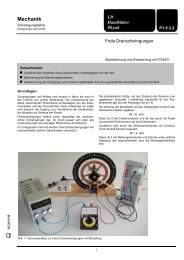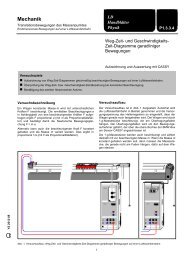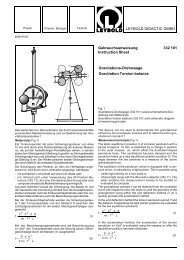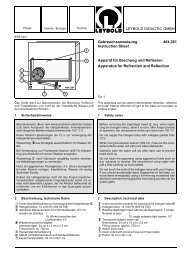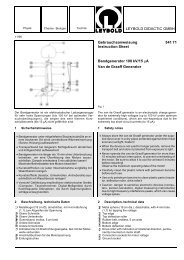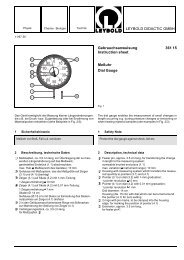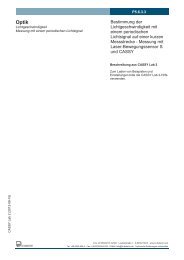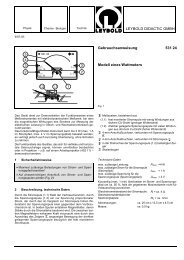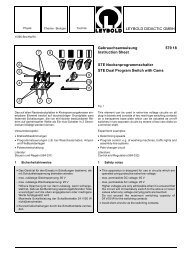LEYBOLD DIDACTIC GMBH Gebrauchsanweisung 586 26 ...
LEYBOLD DIDACTIC GMBH Gebrauchsanweisung 586 26 ...
LEYBOLD DIDACTIC GMBH Gebrauchsanweisung 586 26 ...
Create successful ePaper yourself
Turn your PDF publications into a flip-book with our unique Google optimized e-Paper software.
Physik Chemie ⋅ Biologie Technik <strong>LEYBOLD</strong> <strong>DIDACTIC</strong> <strong>GMBH</strong><br />
3/94-Sf-<br />
<strong>Gebrauchsanweisung</strong> <strong>586</strong> <strong>26</strong><br />
Instruction Sheet<br />
Universalmikrofon<br />
Multi-Purpose Microphone<br />
Fig. 1<br />
Das Universalmikrofon ist ein batteriebetriebener Schalldruckempfänger<br />
für den Tonfrequenzbereich (30 Hz ... 20 kHz), mit<br />
verminderter Empfindlichkeit auch im Ultraschallbereich bis<br />
40 kHz. Ein eingebauter Vorverstärker erlaubt den direkten Anschluß<br />
an Meßgeräte (z.B. Osilloskope, Stoppuhren, Zähler).<br />
Ein Pegelausgang gestattet den Anschluß an Schreiber.<br />
Wegen der eingebauten automatischen Batterieabschaltung<br />
und dem sehr geringen Strombedarf des Vorverstärkers wird<br />
die Lebensdauer der Batterie hauptsächlich von ihrer Lagerfähigkeit<br />
begrenzt (1-2 Jahre).<br />
Versuchsbeispiele:<br />
• Sprach- und Musikaufnahmen<br />
• Reflexion und Interferenz von Schallwellen<br />
• Ansteuern von elektrischen Zeit- und Frequenzmessern,<br />
z.B. zur Messung der Schallgeschwindigkeit oder von Tonfrequenzen<br />
1 Sicherheitshinweise<br />
Mikrofon vor dem Eindringen von Fremdkörpern oder<br />
Feuchtigkeit in das Sondenrohr 1 schützen.<br />
Fremdspannung an der Anschlußleitung: max. 10 V!<br />
The multi-purpose microphone is a battery-operated microphone<br />
for sound waves within the frequency range of 30 Hz to 20 kHz<br />
and, with reduced sensitivity, also for the ultrasonic range up to<br />
40 kHz. An integrated preamplifier enables direct connection of<br />
measuring instruments (e. g. oscilloscope, stop-clocks and<br />
counters). An additional level output is provided for direct<br />
connection to a chart recorder.<br />
In view of the built-in automatic battery cut-out and the very low<br />
power consumption of the preamplifier the battery life is mainly<br />
dependent on the shelf life of the battery itself (1 to 2 years).<br />
Examples of experiments:<br />
• Music and speech recordings<br />
• Reflection and interference of sound waves<br />
• Operation of electric timers and frequency counters for the<br />
measurement of sound velocity or acoustic frequencies<br />
1 Safety notes<br />
Prevent foreign particles or humidity from entering the tube<br />
of the microphone 1.<br />
Max. permissible external voltage applied to connecting<br />
lead: 10 V!<br />
2 Lieferumfang, Beschreibung, technische Daten<br />
(Fig. 1)<br />
1 Sondenrohr, ∅ 8 mm, 25 cm lang, in beliebige Muffen einspannbar<br />
2 Einsprechöffnung mit versenkt eingebauter Mikrofonkapsel<br />
3 Griff mit Vorverstärkerelektronik und Batterie;<br />
Abmessungen: 19 cm x 3,5 cm x 3,5 cm<br />
4 Einschalttaste:<br />
Durch kurze Betätigung Einschalten des Vorverstärkers;<br />
auch während des Betriebes möglich.<br />
Automatische Abschaltung jeweils ca. 30 Minuten nach der<br />
letzten Betätigung der Einschalttaste.<br />
5 Verstärkungseinstellung, kontinuierlich bis zum Faktor 16<br />
variierbar<br />
2 Standard equipment, description, technical data<br />
(Fig. 1)<br />
1 Tube, dia. 8 mm, 25 cm long, mountable into any desired<br />
clamp<br />
2 Mouthpiece with flush microphone capsule<br />
3 Handle with preamplifier electronics and battery<br />
Dimensions: 19 cm x 3.5 cm x 3.5 cm<br />
4 ON pushbutton:<br />
By briefly pressing this button the preamplifier is switched<br />
on. This is also possible during operation.<br />
The device switches off automatically approx. 30 minutes<br />
after last switch-on.<br />
5 Gain adjustment, continuously variable up to a factor of 16
6 Funktionsschalter:<br />
Stellung ": ("Signal"), bei Anschluß an Oszilloskope,<br />
Analogeingang eines Interfaces, Verstärker, Wechselspannungsmeßgerät<br />
Stellung =: ("Pegel"), bei Anschluß an Schreiber<br />
Stellung %: ("Trigger"), bei Anschluß an elektronischen Zeitoder<br />
Frequenzmesser, z.B. LH Digitalzähler (575 40), Elektronische<br />
Stopp- und Schaltuhr D (313 01), Elektronische<br />
Stoppuhr P (313 031), Zählgerät P (575 45),<br />
Digitaleingang eines Interfaces (z. B. aus 524 007)<br />
7 Ausgangskabel, 2 m lang, mit einem schwarzen ("Masse")<br />
und einem gelben ("Signal") 4-mm-Stecker.<br />
8 Batteriefach (für 9-V-Blockbatterie), durch Kunststoffschieber<br />
verschlossen<br />
9 Stativstange mit Gewinde, 22 cm x 1 cm ∅, zum Einschrauben<br />
in die Gewindebuchse im Griffboden.<br />
Ohne Abbildung: Batterie 9 V (nach IEC 6F 22)<br />
Technische Daten:<br />
Wandler: Electret-Kapsel, ∅ 5 mm, an der Spitze des Sondenrohrs.<br />
Daten des Mikrofons einschließlich Vorverstärker:<br />
Frequenzbereich: 30 Hz ... 20 kHz (40 kHz)<br />
Richtcharakteristik: Kugel<br />
Empfindlichkeit, bezogen auf den Signalausgang:<br />
ca. 18 ... 300 mV/µbar bei 1 kHz, abhängig von der Verstärkung<br />
Grenzschalldruck: ca. 100 dB<br />
Signalausgang:<br />
Aussteuerbarkeit: 4 V ss bei Anschluß an Geräte mit R i ≥ 20 kΩ<br />
Ausgangsimpedanz: < 1 kΩ (f > 60 Hz)<br />
Pegelausgang:<br />
Ausgangsimpedanz: 10 kΩ<br />
Aussteuerbarkeit: > 1 V<br />
Nichtlinearität: ca. 50 mV<br />
Triggerausgang:<br />
Widerstandssteuerung (Open-Collector-Ausgang),<br />
Vorspannung; max. 10 V<br />
Strom: max. 20 mA<br />
Spannungsversorgung:<br />
9-V-Blockbatterie (685 45) nach IEC 6F 22<br />
Stromaufnahme: 1,3 mA<br />
Abmessungen ohne Stativstange: 45 cm x 3,5 cm x 3,5 cm<br />
Masse: 0,45 kg<br />
3 Bedienung<br />
3.1 Anschluß an Wechselspannungsmeßgeräte,<br />
Oszilloskop oder Verstärker<br />
Funktionsschalter 6 auf " ("Signal"), am Meßgerät passenden<br />
Wechselspannungsbereich einstellen. Eingangsimpedanz des<br />
verwendeten Meßgerätes > 20 kΩ, sonst Verringerung der Aussteuerbarkeit<br />
(Signalbegrenzung).<br />
3.2 Anschluß an Schreiber<br />
Funktionsschalter 6 auf = ("Pegel")<br />
Eingangsimpedanz des Schreibers ≥ 100 kΩ<br />
3.3 Anschluß an Zähler und Stoppuhr<br />
Funktionsschalter 6 auf %("Trigger") schwarzen Stecker des<br />
Anschlußkabels stets mit der Gerätebuchse verbinden, die mit<br />
dem Massesymbol ⊥ gekennzeichnet ist.<br />
3.4 Batteriewechsel<br />
Batteriefach 8 öffnen (Schieber seitlich herausziehen), Batterie<br />
entnehmen, neue Batterie (685 45) einsetzen; Batteriefach<br />
schließen.<br />
6 Function switch:<br />
Position " : ("signal"), if oscilloscope, amplifiers or AC voltmeter<br />
are connected.<br />
Position =: ("level"), if a chart recorder is connected.<br />
Position % : ("trigger"), if any of the following instruments is<br />
connected: electronic timers or frequency meters, e. g. LH<br />
digital counter (575 40), electronic stop-clock D (313 01),<br />
electronic stop-clock P (313 031), counter P (575 45), or digital<br />
input of an interface (e.g. from 524 007).<br />
7 Output cable, 2 m long, with one black ("earth") and one yellow<br />
("signal") 4-mm plug.<br />
8 Battery compartment (for 9-V block battery), with sliding<br />
cover<br />
9 Stand rod with thread, 22 cm x 1 cm dia., to be screwed into<br />
the matching socket in the bottom of the handle.<br />
Not shown: Battery 9 V (according to IEC 6F 22)<br />
Technical data:<br />
Transducer: electret capsule, 5 mm dia., at the tip of the tube.<br />
Data of microphone including preamplifier:<br />
Frequency range: 30 Hz to 20 kHz (40 kHz)<br />
Characteristic: omnidirectional<br />
Sensitivity, related to signal output:<br />
approx. 18 to 300 mV/µbar at 1 kHz, depending on gain<br />
Sound-level limit: 100 dB<br />
Signal output:<br />
Operating limit: 4 V pp for connection to instruments with R i ≥ 20 kΩ<br />
Output impedance: < 1 kΩ (f > 60 Hz)<br />
Level output:<br />
Output impedance: 10 kΩ<br />
Operating limit: > 1 V<br />
Nonlinearity: approx. 50 mV<br />
Trigger output:<br />
Open-collector output<br />
Bias voltage: 10 V max.<br />
Current: 20 mA max.<br />
Power supply:<br />
9 V block battery (685 45) according to IEC 6F 22<br />
Current drain: 1.3 mA<br />
Dimensions without stand rod: 45 cm x 3.5 cm x 3.5 cm<br />
Weight: 0.45 kg<br />
3 Operation<br />
3.1 Connection to AC voltmeters, oscilloscope or<br />
amplifier<br />
Set function switch 6 to " ("signal") and select a suitable AC<br />
voltage range on measuring instrument. Input impedance of<br />
measuring instrument used should exceed > 20 kΩ, otherwise<br />
reduction of operating limit (signal limiting).<br />
3.2 Connection to chart recorder<br />
Set function switch 6 to = ("level").<br />
Input impedance of chart recorder ≥ 100 kΩ.<br />
3.3 Connection to counter or stop-clock<br />
Set function switch 6 to %("trigger"). Always connect black<br />
plug of connecting lead to the instrument socket marked with<br />
the earth symbol ⊥.<br />
3.4 Replacing the battery<br />
Open battery compartment 8 by sliding the cover to the<br />
side, remove battery, insert new battery (685 45) and close<br />
battery compartment.<br />
<strong>LEYBOLD</strong> <strong>DIDACTIC</strong> <strong>GMBH</strong> ⋅ Leyboldstrasse 1 ⋅ D-50354 Hürth ⋅ Phone (02233) 604-0 ⋅ Telefax (02233) 604-222 ⋅ Telex 17 223 332 LHPCGN D<br />
© by Leybold Didactic GmbH, Printed in the Federal Republic of Germany<br />
Technical alterations reserved


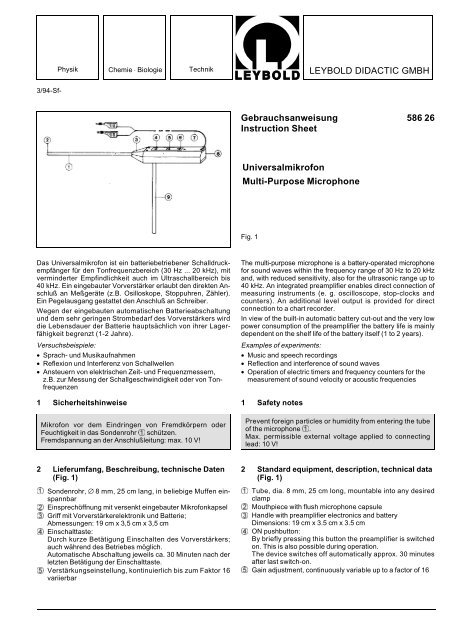
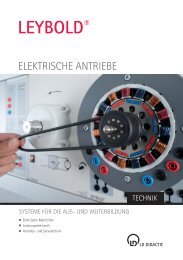
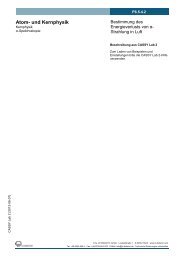
![[667 359] Labor-Refraktometer - LD DIDACTIC](https://img.yumpu.com/24788329/1/184x260/667-359-labor-refraktometer-ld-didactic.jpg?quality=85)
